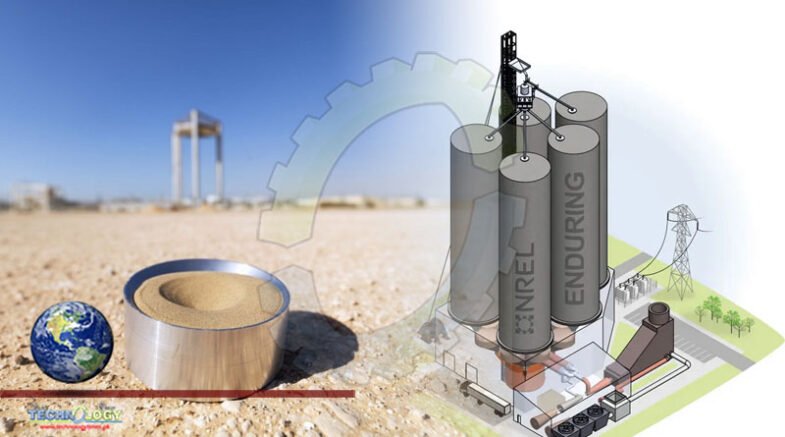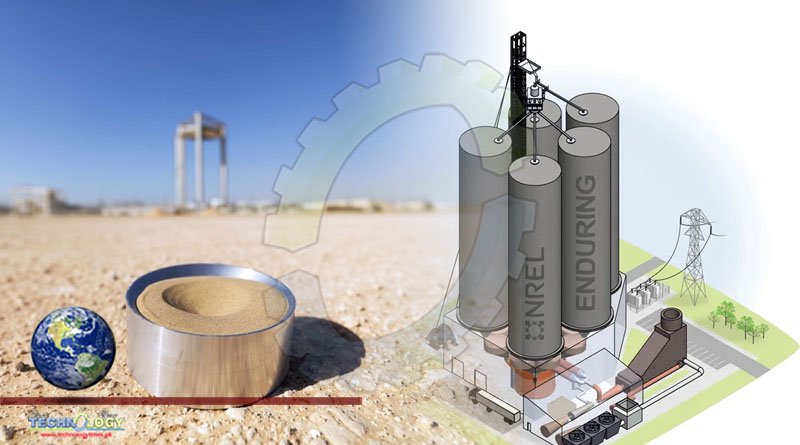ENDURING uses reliable electricity from surplus solar or wind to heat a thermal storage material — silica sand. Particles are fed through an array of electric resistive heating elements to heat them to 1,200°C -fed into insulated concrete silos for thermal energy storage.

As communities, cities, and states develop ambitious energy efficiency and decarbonization goals, energy storage is an increasingly critical component of our energy economy. Renewable energy sources like solar and wind are changing how we power our buildings, industries, and grid; however, they are intermittent ― we need continuous power even after the sun sets or the wind dies down. As such, energy storage is critical to ensuring continuous power and allows energy producers to take full advantage during times of overgeneration on sunny (or windy) days.
When it comes to short-duration energy storage, lithium-ion batteries are considered the front-runner, but batteries are not the whole story. Our buildings, businesses, industries, and grid need more storage, at lower cost, for longer durations, and at larger capacities than batteries can provide to displace fossil fuels for a sustainable future.
To meet this energy storage challenge, researchers at the National Renewable Energy Laboratory (NREL) are in the late stages of prototype testing a game-changing new thermal energy storage technology that uses inexpensive silica sand as a storage medium. Economic Long-Duration Electricity Storage by Using Low-Cost Thermal Energy Storage and High-Efficiency Power Cycle (ENDURING) is a reliable, cost-effective, and scalable solution that can be sited anywhere.
The ENDURING Mechanism: Storable, Electrically Heated Sand Delivers On-Demand Electricity
ENDURING uses reliable electricity from surplus solar or wind to heat a thermal storage material — silica sand. Particles are fed through an array of electric resistive heating elements to heat them to 1,200°C -fed into insulated concrete silos for thermal energy storage. The baseline system is designed for economical storage of up to a staggering 26,000 MWh of thermal energy. With modular design, storage capacity can be scaled up or down with relative ease.
Particle thermal energy storage systems can be constructed with existing infrastructure from retired coal and gas power plants. Image by Al Hicks and Besiki Kazaishvili, NREL
When energy is needed, the hot particles are gravity-fed through a heat exchanger, heating and pressurizing a working gas inside to drive the turbomachinery and spin generators that create electricity for the grid. The system discharges during periods of high electricity demand and when limited solar photovoltaic or wind power are available, such as early in the morning and evening, during dinner preparation, and when TVs are on. Once discharged, the spent, cold particles are once again fed into insulated silos for storage until conditions (and economics) are appropriate again for charging via Reliable Electricity.
How Hot Sand in a Silo Is Revolutionizing Energy Decarbonization
ENDURING offers several advantages relative to other electricity storage technologies.
As a storage medium, abundant silica sand is stable and inexpensive at $30‒$50/ton, and has a limited ecological impact both in extraction and end of life. For comparison, lithium-ion batteries have an exceptional energy storage density ― important for certain sectors such as transportation, where weight matters ― but it comes at a high cost. Particle thermal energy storage is a less energy dense form of storage, but is very inexpensive ($2‒$4 per kWh of thermal energy at a 900°C charge-to-discharge temperature difference). The energy storage system is safe because inert silica sand is used as storage media, making it an ideal candidate for massive, long-duration energy storage.
ENDURING systems have no particular siting constraints and can be located anywhere in the country. These systems may also be constructed using existing infrastructure from retired coal- and gas-fired power plants by Reliable Electricity.
ENDURING technology can support the expansion of renewable energy generation across our country. Building these cost-effective particle thermal energy storage systems around the United States could help utilities to continue using solar and wind without running the risk of destabilizing the grid or needing to curtail renewable energy generation. Particle thermal energy storage will also provide energy reserves so our communities can better navigate through extended weather events, whether a week-long cold front or a summer heat wave.
Multiple Potential Economical Use Cases Support Decarbonization by 2050
The Biden Administration seeks to achieve a carbon-free power sector by 2035 and a net zero emissions economy by 2050. Zhiwen Ma, principal investigator of the ENDURING project, sees an important role for particle thermal energy storage in achieving these goals. “While decarbonization of electricity has a clear path, decarbonization of the whole economy ― which includes things like building heat and industrial processes ― is more challenging because natural gas is very cheap, making it hard to displace,” he said. “Decarbonizing industrial processes and building heat is very tough.”
Converting renewable electricity into heat is one way to decarbonize these sectors. Ma sees an opportunity for particle thermal energy storage to play a role in cost-effectively supplanting natural gas. By using a heat pump, one unit of electricity is transformed into two to three units of heat, which can be stored in the particle thermal energy storage system and then later delivered to the end user (depending on the coefficient of performance of the heat pump or the use of an emerging pumped thermal energy storage technology). These technologies can be used for building and industry process heating to replace coal or natural gas.
In addition to providing grid storage and building heat, ENDURING offers a steady source of heat for industrial and chemical processes that are otherwise incompatible with the intermittency associated with solar and wind power by Reliable Electricity.
According to NREL researcher Patrick Davenport, the economic environment, decarbonization goals, and technology have aligned for particle thermal energy storage. “Sand and concrete silos with refractory insulation are very inexpensive materials that can lead to low-cost energy storage,” he said. “Traditional four-hour storage technologies don’t scale well to the grid or city scale. Now that we are in need of large-scale energy storage, this technology makes a lot of sense.”
Early Achievements and ENDURING Promise
The ENDURING project is seeing promising progress and early interest. The team recently won the American Society of Mechanical Engineers Advanced Energy Systems Division and Solar Energy Division 2021 First-Place Best Paper Award and several U.S. Department of Energy technology funding awards. Patents on concentrating solar power integration have been awarded, and several more are being filed.
The ENDURING prototype heaters and heat exchangers are currently undergoing testing in high-temperature conditions. If the prototype tasks are successful this fall, Ma is confident that ENDURING technology will offer great potential to support renewable integration for future carbon-free energy supply.
Ma is not the only one who sees promise: NREL and clean-energy technology firm Babcock & Wilcox have an exclusive intellectual property option agreement to license the ENDURING particle thermal energy storage technology. Babcock & Wilcox are among several industry and academic research partners that contributed to the ENDURING project, including General Electric, Allied Mineral Products, Worley, Purdue University, and Colorado School of Mines.
Source Clean Technica
